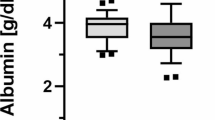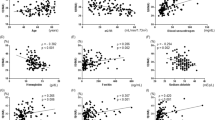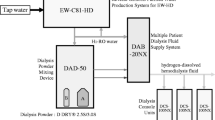Abstract
Aims
Nephropathic patients show higher levels of advanced glycation end products (AGEs) and oxidized human serum albumin (HSAox) compared to healthy subjects. These two classes of compounds are formed as the result of oxidative insults; for this reason, they can be useful oxidative stress biomarkers. The present study examines the variation of AGEs and HSAox in hemodialysis (HD) patients before and after dialysis session, evaluating the impact of different dialytic techniques and filters on their removal.
Methods
A total of 50 healthy subjects (control group) and 130 HD patients were enrolled in the study. Hemodialysis patients were subdivided based on dialytic techniques: 109 in diffusive technique and 22 in convective technique. We monitored HSAox, AGEs and other laboratory parameters at early morning in healthy subjects and in HD patients before and after the dialysis procedures.
Results
The level of HSAox decreases after a single dialytic session (from 58.5 ± 8.8% to 41.5 ± 11.1%), but the concentration of total AGEs increases regardless of adopted dialytic techniques (from 6.8 ± 5.2 µg/ml to 9.2 ± 4.4 µg/ml). In our study, levels of HSAox and total AGEs are similar in diabetic and non-diabetic HD patients. The increase in total AGEs after dialysis was only observed using polysulfone filters but was absent with polymethacrylate filters.
Conclusions
HSAox is a simple and immediate method to verify the beneficial effect of a single dialysis session on the redox imbalance, always present in HD patients. Total AGEs assayed by ELISA procedure seem to be a less reliable biomarker in this population.

Similar content being viewed by others
Data availability
The data used to support the findings of this study are available from the corresponding author upon request.
Abbreviations
- AGEs:
-
Advanced glycation end products
- BSA:
-
Bovine serum albumin
- CKD:
-
Chronic kidney disease
- DTNB:
-
5,5′-Dithiobis(2-nitrobenzoic) acid
- ESRD:
-
End-stage renal disease
- e-GFR:
-
Estimated glomerular filtration rate
- GFR:
-
Glomerular filtration rate
- Glo 1:
-
Glyoxalase 1
- HD:
-
Hemodialysis
- HF:
-
Hemoperfusion
- HSAox:
-
Oxidized human serum albumin
- IGF-1:
-
Insulin growth factor-1
- IL-1β:
-
Interleukin-1β
- MG:
-
Methylglyoxal
- NADPH:
-
Nicotinamide adenine dinucleotide phosphate
- Pdiast:
-
Diastolic blood pressure
- Psyst:
-
Systolic blood pressure
- PTV:
-
Policlinico Tor Vergata
- RAGE:
-
AGE cell receptor
- RCTs:
-
Randomized clinical trials
- ROS:
-
Reactive oxygen species
- SD:
-
Standard deviation
- sRAGE:
-
AGE soluble receptor
- TNF-α:
-
Tumor necrosis factor-α
References
Rabbani N, Thornalley PJ (2018) Advanced glycation end products in the pathogenesis of chronic kidney disease. Kidney Int 93(4):803–813. https://doi.org/10.1016/j.kint.2017.11.034
Wolley M, Jardine M, Hutchison CA (2018) Exploring the clinical relevance of providing increased removal of large middle molecules. Clin J Am Soc Nephrol 13(5):805–814. https://doi.org/10.2215/CJN.10110917
Henle T, Deppisch R, Beck W, Hergesell O, Hansch GM, Ritz E (1999) Advanced glycated end-products (AGE) during haemodialysis treatment: discrepant results with different methodologies reflecting the heterogeneity of AGE compounds. Nephrol Dial Transplant 14(8):1968–1975
Stinghen AE, Massy ZA, Vlassara H, Striker GE, Boullier A (2016) Uremic toxicity of advanced glycation end products in CKD. J Am Soc Nephrol 27(2):354–370. https://doi.org/10.1681/ASN.2014101047
Thornalley PJ (2006) Advanced glycation end products in renal failure. J Ren Nutr 16(3):178–184. https://doi.org/10.1053/j.jrn.2006.04.012
Agalou S, Ahmed N, Babaei-Jadidi R, Dawnay A, Thornalley PJ (2005) Profound mishandling of protein glycation degradation products in uremia and dialysis. J Am Soc Nephrol 16(5):1471–1485. https://doi.org/10.1681/ASN.2004080635
Prasad K, Mishra M (2018) AGE-RAGE stress, stressors, and antistressors in health and disease. Int J Angiol 27(1):1–12. https://doi.org/10.1055/s-0037-1613678
Wautier MP, Chappey O, Corda S, Stern DM, Schmidt AM, Wautier JL (2001) Activation of NADPH oxidase by AGE links oxidant stress to altered gene expression via RAGE. Am J Physiol Endocrinol Metab 280(5):E685–E694. https://doi.org/10.1152/ajpendo.2001.280.5.E685
Koyama H, Yamamoto H, Nishizawa Y (2007) RAGE and soluble RAGE: potential therapeutic targets for cardiovascular diseases. Mol Med 13(11–12):625–635. https://doi.org/10.2119/2007-00087.Koyama
Inagi R (2016) RAGE and glyoxalase in kidney disease. Glycoconj J 33(4):619–626. https://doi.org/10.1007/s10719-016-9689-8
Loomis SJ, Chen Y, Sacks DB et al (2017) Cross-sectional analysis of AGE-CML, sRAGE, and esRAGE with diabetes and cardiometabolic risk factors in a community-based cohort. Clin Chem 63(5):980–989. https://doi.org/10.1373/clinchem.2016.264135
Peters T Jr (1995) The albumin molecule: its structure and chemical properties. In: Diego S (ed) In all about albumin: biochemistry, genetics, and molecular applications. Academic press, New York, pp 9–75
Ascenzi P, Bocedi A, Bolli A, Fasano M, Notari S, Polticelli F (2005) Allosteric modulation of monomeric proteins*. Biochem Mol Biol Educ 33(3):169–176. https://doi.org/10.1002/bmb.2005.494033032470
Ascenzi P, Bocedi A, Notari S, Fanali G, Fesce R, Fasano M (2006) Allosteric modulation of drug binding to human serum albumin. Mini Rev Med Chem 6(4):483–489
Bocedi A, Cattani G, Stella L, Massoud R, Ricci G (2018) Thiol disulfide exchange reactions in human serum albumin: the apparent paradox of the redox transitions of Cys34. FEBS J 285(17):3225–3237. https://doi.org/10.1111/febs.14609
Bocedi A, Noce A, Rovella V et al (2018) Erythrocyte glutathione transferase in kidney transplantation: a probe for kidney detoxification efficiency. Cell Death Dis 9(3):288. https://doi.org/10.1038/s41419-018-0289-3
Watanabe H, Imafuku T, Otagiri M, Maruyama T (2017) Clinical implications associated with the posttranslational modification-induced functional impairment of albumin in oxidative stress-related diseases. J Pharm Sci 106(9):2195–2203. https://doi.org/10.1016/j.xphs.2017.03.002
Terawaki H, Nakayama K, Matsuyama Y et al (2007) Dialyzable uremic solutes contribute to enhanced oxidation of serum albumin in regular hemodialysis patients. Blood Purif 25(3):274–279. https://doi.org/10.1159/000101986
Terawaki H, Yoshimura K, Hasegawa T et al (2004) Oxidative stress is enhanced in correlation with renal dysfunction: examination with the redox state of albumin. Kidney Int 66(5):1988–1993. https://doi.org/10.1111/j.1523-1755.2004.00969.x
Nagumo K, Tanaka M, Chuang VT et al (2014) Cys34-cysteinylated human serum albumin is a sensitive plasma marker in oxidative stress-related chronic diseases. PLoS ONE 9(1):e85216. https://doi.org/10.1371/journal.pone.0085216
Himmelfarb J, McMonagle E (2001) Albumin is the major plasma protein target of oxidant stress in uremia. Kidney Int 60(1):358–363. https://doi.org/10.1046/j.1523-1755.2001.00807.x
Oettl K, Marsche G (2010) Redox state of human serum albumin in terms of cysteine-34 in health and disease. Methods Enzymol 474:181–195. https://doi.org/10.1016/S0076-6879(10)74011-8
Bocedi A, Noce A, Fabrini R, Di Daniele N, Galli F, Ricci G (2015) Erythrocyte glutathione transferase as a biomarker in kidney health and disease. In: Patel V (ed) Biomarkers in kidney disease. Springer, Dordrecht, pp 577–598. https://doi.org/10.1007/978-94-007-7743-9_44-1
Liakopoulos V, Roumeliotis S, Gorny X, Dounousi E, Mertens PR (2017) Oxidative stress in hemodialysis patients: a review of the literature. Oxid Med Cell Longev 2017:3081856. https://doi.org/10.1155/2017/3081856
Dessi M, Noce A, Agnoli A et al (2009) The usefulness of the prognostic inflammatory and nutritional index (PINI) in a haemodialysis population. Nutr Metab Cardiovasc Dis 19(11):811–815. https://doi.org/10.1016/j.numecd.2009.01.009
Liabeuf S, Drueke TB, Massy ZA (2011) Protein-bound uremic toxins: new insight from clinical studies. Toxins (Basel) 3(7):911–919. https://doi.org/10.3390/toxins3070911
Gerdemann A, Wagner Z, Solf A et al (2002) Plasma levels of advanced glycation end products during haemodialysis, haemodiafiltration and haemofiltration: potential importance of dialysate quality. Nephrol Dial Transplant 17(6):1045–1049
Zhang Y, Mei CL, Rong S et al (2015) Effect of the combination of hemodialysis and hemoperfusion on clearing advanced glycation end products: a prospective, randomized, two-stage crossover trial in patients under maintenance hemodialysis. Blood Purif 40(2):127–132. https://doi.org/10.1159/000376604
De Smet R, Dhondt A, Eloot S, Galli F, Waterloos MA, Vanholder R (2007) Effect of the super-flux cellulose triacetate dialyser membrane on the removal of non-protein-bound and protein-bound uraemic solutes. Nephrol Dial Transplant 22(7):2006–2012. https://doi.org/10.1093/ndt/gfm065
Feng G, Gao JL, Zhang P et al (2017) Decreased serum extracellular superoxide dismutase activity is associated with albuminuria in Chinese patients with type 2 diabetes mellitus. Acta Diabetol 54(11):1047–1055. https://doi.org/10.1007/s00592-017-1048-0
Bo S, Togliatto G, Gambino R et al (2018) Impact of sirtuin-1 expression on H3K56 acetylation and oxidative stress: a double-blind randomized controlled trial with resveratrol supplementation. Acta Diabetol 55(4):331–340. https://doi.org/10.1007/s00592-017-1097-4
Acknowledgements
We would like to thank Caterina Gola for her English language revision.
Funding
The present study was supported by Federazione Medico Sportiva Italiana; by Mission: Sustainability Grant to A.B. [Decreto Rettorale 2817/2016].
Author information
Authors and Affiliations
Corresponding authors
Ethics declarations
Conflict of interest
The authors declare that there is no conflict of interest regarding the publication of this paper.
Ethical Standard Statement
All procedures performed in studies involving human participants were in accordance with the ethical standards of the institutional and/or national research committee “Comitato Etico Indipendente”—Azienda Ospedaliera Universitaria Policlinico Tor Vergata (experimentation Register Number 60/16) and with the 1964 Helsinki declaration and its later amendments or comparable ethical standards.
Informed consent
Informed consent was obtained from all individual participants included in the study.
Additional information
Managed By Giuseppe Pugliese.
Publisher's Note
Springer Nature remains neutral with regard to jurisdictional claims in published maps and institutional affiliations.
Rights and permissions
About this article
Cite this article
Noce, A., Rovella, V., Marrone, G. et al. Hemodialysis biomarkers: total advanced glycation end products (AGEs) against oxidized human serum albumin (HSAox). Acta Diabetol 56, 1323–1331 (2019). https://doi.org/10.1007/s00592-019-01413-7
Received:
Accepted:
Published:
Issue Date:
DOI: https://doi.org/10.1007/s00592-019-01413-7




